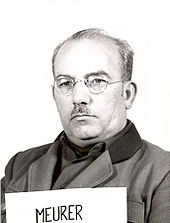Fritz Meurer
Friedrich Wilhelm Meurer , called Fritz (born November 30, 1896 in Lahr / Black Forest , † after 1975) was a German officer .
Life and activity
Early years
In his youth Meurer attended elementary school and a humanistic grammar school from 1902 to 1912. In 1912 he passed the annual. Then he was a volunteer in a machine factory and an electricity company until August 1914.
From August 1914, Meurer took part in the First World War as a volunteer . On September 23, 1915 he was appointed lieutenant in the reserve . He then studied electrical engineering for five semesters at the Technikum in Mittweida. He passed the engineering exam in 1921.
From 1921 to 1925 Meurer then worked as an engineer in the Tauberbischofsheim and Sinsheim offices of the Baden state electricity supply in Karlsruhe.
In the spring of 1925 Meurer became a civilian employee of the Reichswehr at the military district command V in Stuttgart. There he was employed in the state protection department. Politically, he had been a member of the NSDAP since 1932 .
Nazi period until 1944
In the fall of 1933 Meurer joined the Sturmabteilung (SA) as a full-time functionary , where he took over the post of head of training at SA-Obergruppe 5 (Frankfurt am Main). He held this position for almost a year and a half until May 1935. However, since the summer of 1934 the organization of the head of training had been detached from the SA and existed as an independent structure. Within the SA Meurer achieved the rank of Sturmbannführer .
In 1935 Meurer returned to the military: on May 1, 1935, he was reactivated as a supplementary officer with the rank of captain and assigned to the military administration: from May 1, 1935 to December 31, 1938, he served as an adjutant at the military district command in Stuttgart 1. During this time he was promoted to major on May 31, 1938 .
On January 1, 1939, Meurer was transferred to the military replacement inspection in Karlstadt, of which he was a member until the beginning of the Second World War. During the war he was first moved to Nuremberg, then briefly to division z. b. V. 13 and finally transferred to the staff of the military replacement inspection in Eger . He then headed a transit camp on the Eastern Front . In this phase of the war he was on September 1, 1941 Lieutenant Colonel and on September 1, 1944 Colonel promoted.
Chief of Staff at the Chief of Prisoners of War (1944–1945)
After Gottlob Berger was appointed head of the Wehrmacht's prisoner-of-war system on October 1, 1944, he chose Meurer, who was an old friend of his from his Swabian homeland, as his chief of staff. Since Berger was largely absorbed by numerous other functions, his official business as head of the prisoner-of-war system was - according to a dispute - "essentially" performed by Meurer.
In December 1944 and January 1945, Meurer organized the murder of the prisoner-of-war French general Mesny , who was shot by subordinates of Meurer on January 18, 1945 on behalf of Berger .
post war period
After the Second World War , Meurer was interrogated as a witness during the Nuremberg Trials , in particular trying to obtain information from him about the organization of the German prisoner-of-war system during the World War and about the murder of General Mesny.
On September 28, 1953, Meurer was sentenced to death in absentia in Paris . In November 1959 German authorities issued an arrest warrant for his role in the killing of Mesny. He initially remained until April 1960 in custody . In May, the chief public prosecutor in Essen presented the indictment. The preliminary investigation against him dragged on and was finally closed in 1976 due to inability to stand trial .
family
Meurer was married and had three children.
literature
Extensive considerations:
- Sebastian Weitkamp: "Murder with a clean slate". The murder of General Maurice Mesny in January 1945. , in: Timm C. Richter (Ed.): War and crime - situation and intention: case studies. Martin Meidenbauer Verlag / Peter Lang, Munich 2006, pp. 31–40.
- Ders: "Anatomy of a war crime - the murder of General Maurice Mesny in January 1945", in: Ders .: Brown diplomats. Horst Wagner and Eberhard von Thadden as functionaries of the “Final Solution” . J. H. W. Dietz, Bonn 2008, ISBN 978-3-8012-4178-0 , pp. 327-370, also 371-386 and 409-416.
Entries in reference works:
- Ernst Klee : The dictionary of persons on the Third Reich . Who was what before and after 1945 . 2nd Edition. Fischer-Taschenbuch-Verlag, Frankfurt am Main 2007, ISBN 978-3-596-16048-8 .
- Ernst Schraepler: causes and consequences. From the German collapse in 1918 and 1945 to the state reorganization of Germany in the present. A collection of certificates and documents on contemporary history , vol. 2, p. 483.
Web links
- Minutes of Meurer's interrogations in the years 1946 and 1947 at the Institute for Contemporary History (Witness literature Meurer 1) (PDF; 16.4 MB)
- Minutes of Meurer's interrogations in 1946 and 1947 at the Institute for Contemporary History (Meurer 2) (PDF; 12.3 MB)
Individual evidence
- ^ A b Ernst Klee: Das Personenlexikon zum Third Reich , Frankfurt am Main 2007, p. 406.
- ↑ Christian Streit: No comrades: the Wehrmacht and the Soviet prisoners of war 1941–1945 , 1991, p. 291.
| personal data | |
|---|---|
| SURNAME | Meurer, Fritz |
| ALTERNATIVE NAMES | Meurer, Friedrich Wilhelm (full name) |
| BRIEF DESCRIPTION | German officer, most recently colonel in World War II |
| DATE OF BIRTH | November 30, 1896 |
| PLACE OF BIRTH | Lahr / Black Forest |
| DATE OF DEATH | 20th century |
